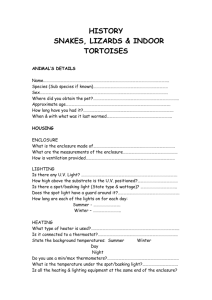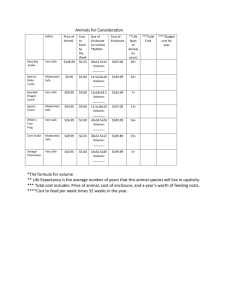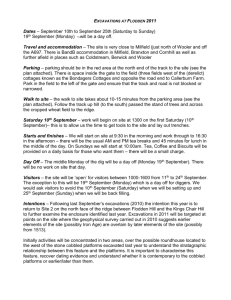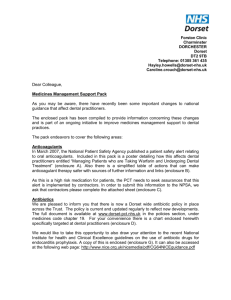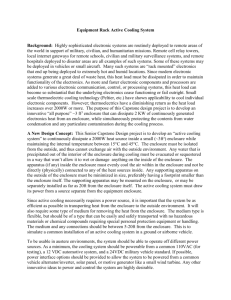Chapter 3 - New Landscapes
advertisement
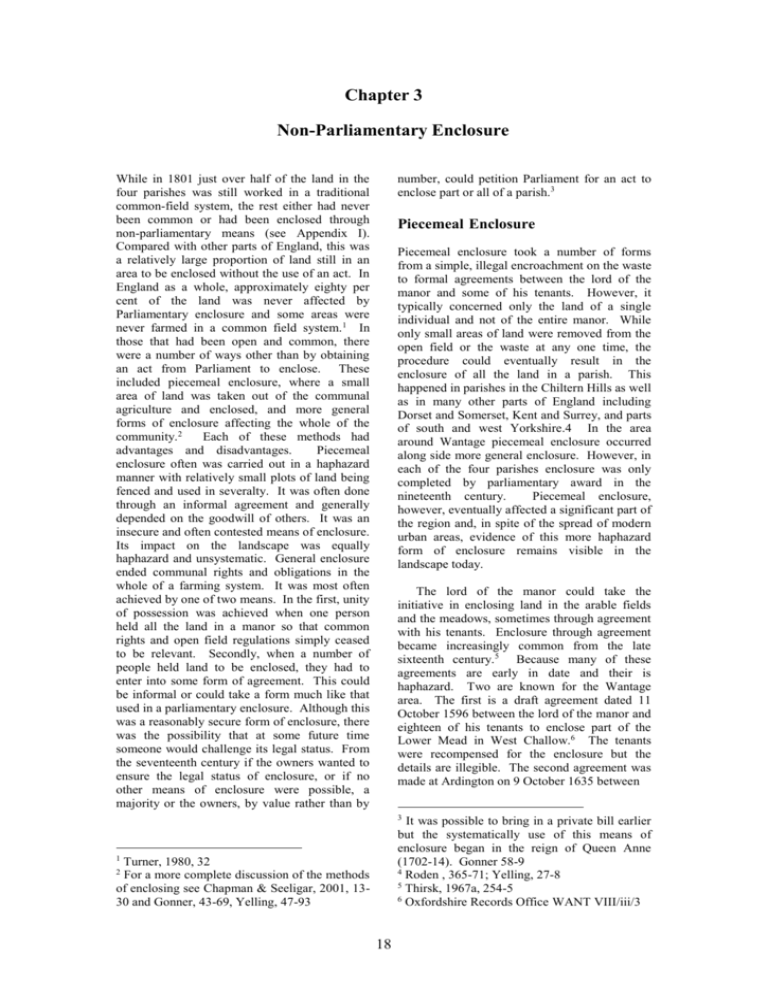
Chapter 3 Non-Parliamentary Enclosure While in 1801 just over half of the land in the four parishes was still worked in a traditional common-field system, the rest either had never been common or had been enclosed through non-parliamentary means (see Appendix I). Compared with other parts of England, this was a relatively large proportion of land still in an area to be enclosed without the use of an act. In England as a whole, approximately eighty per cent of the land was never affected by Parliamentary enclosure and some areas were never farmed in a common field system. 1 In those that had been open and common, there were a number of ways other than by obtaining an act from Parliament to enclose. These included piecemeal enclosure, where a small area of land was taken out of the communal agriculture and enclosed, and more general forms of enclosure affecting the whole of the community.2 Each of these methods had advantages and disadvantages. Piecemeal enclosure often was carried out in a haphazard manner with relatively small plots of land being fenced and used in severalty. It was often done through an informal agreement and generally depended on the goodwill of others. It was an insecure and often contested means of enclosure. Its impact on the landscape was equally haphazard and unsystematic. General enclosure ended communal rights and obligations in the whole of a farming system. It was most often achieved by one of two means. In the first, unity of possession was achieved when one person held all the land in a manor so that common rights and open field regulations simply ceased to be relevant. Secondly, when a number of people held land to be enclosed, they had to enter into some form of agreement. This could be informal or could take a form much like that used in a parliamentary enclosure. Although this was a reasonably secure form of enclosure, there was the possibility that at some future time someone would challenge its legal status. From the seventeenth century if the owners wanted to ensure the legal status of enclosure, or if no other means of enclosure were possible, a majority or the owners, by value rather than by number, could petition Parliament for an act to enclose part or all of a parish.3 Piecemeal Enclosure Piecemeal enclosure took a number of forms from a simple, illegal encroachment on the waste to formal agreements between the lord of the manor and some of his tenants. However, it typically concerned only the land of a single individual and not of the entire manor. While only small areas of land were removed from the open field or the waste at any one time, the procedure could eventually result in the enclosure of all the land in a parish. This happened in parishes in the Chiltern Hills as well as in many other parts of England including Dorset and Somerset, Kent and Surrey, and parts of south and west Yorkshire.4 In the area around Wantage piecemeal enclosure occurred along side more general enclosure. However, in each of the four parishes enclosure was only completed by parliamentary award in the nineteenth century. Piecemeal enclosure, however, eventually affected a significant part of the region and, in spite of the spread of modern urban areas, evidence of this more haphazard form of enclosure remains visible in the landscape today. The lord of the manor could take the initiative in enclosing land in the arable fields and the meadows, sometimes through agreement with his tenants. Enclosure through agreement became increasingly common from the late sixteenth century.5 Because many of these agreements are early in date and their is haphazard. Two are known for the Wantage area. The first is a draft agreement dated 11 October 1596 between the lord of the manor and eighteen of his tenants to enclose part of the Lower Mead in West Challow.6 The tenants were recompensed for the enclosure but the details are illegible. The second agreement was made at Ardington on 9 October 1635 between 3 It was possible to bring in a private bill earlier but the systematically use of this means of enclosure began in the reign of Queen Anne (1702-14). Gonner 58-9 4 Roden , 365-71; Yelling, 27-8 5 Thirsk, 1967a, 254-5 6 Oxfordshire Records Office WANT VIII/iii/3 1 Turner, 1980, 32 For a more complete discussion of the methods of enclosing see Chapman & Seeligar, 2001, 1330 and Gonner, 43-69, Yelling, 47-93 2 18 John Clarke, lord of the manor, and twenty-four of his tenants. Clarke wanted to enclose nineteen lands of arable ground adjoining his manor house that he considered ‘fitt & necessary for the keeping of milche beasts for the provision of his howse’. This arable land, known as the Kitchin Peice, was breached or opened for common grazing from the Feast of All Saints [1 November] until it was again to be made several and sown (see fig. 3.1). In return for their consent, Clarke granted his tenants the right of commoning on a like quantity of land by Ickleton Way that was at that time only available for the lord’s use. In addition, Clarke agreed to improve the North Marsh Common by grubbing up some of the bushes growing there.7 Agreements could also be made between smaller owners. In the early years of the eighteenth century a number of the landowners in the Fig 3.1 Kitchin Peice, Ardington was enclosed and hamlet of Grove chose to enclose an converted from arable to a cow pasture near his manor house area that by 1754 was aptly known as by John Clarke in 1635. In return he extended the common the ‘New Broke Land’.8 Although no rights of those tenants involved to land by Ickleton Way that formal agreement has been found for had previously been several. This is a typical piecemeal these enclosures, a deed of 1720 enclosure by the lord of the manor. recites the terms and conditions of Source: BRO D/EL P1 one agreement along with the manner in which the allocation was to be made. On 6 of with provision of roads and footpaths and April 1719, seven people agreed to divide and responsibility for them. However, the impact on enclose just under 55 acres of common land used the landscape of piecemeal enclosure was very for grazing sheep. The first four plots, two of unlike that of parliamentary enclosure. 10 The nine acres, one of five acres and the last of four New Broke Land in Grove illustrates the result and a half acres, were allotted to men with of piecemeal enclosure - small, irregularly specific requests that the land be near their shaped enclosures with considerable dwellings or other ground. The other three plots fragmentation and a lack of consolidation (see of nine acres each were allocated by lot with fig. 3.2). After enclosure the land use practised each man drawing a clay ball, with an allocation in the small closes was much more varied than inside, out of a bag. The agreement specified that in the original area. Some closes remained roads and bridleways to be built and maintained in pasture while others were converted to in each allotment along with who had the right tillage.11 The size of the closes would have to feed the verges. All were to make mounds to made them ideal for grazing or for growing high mark the boundaries of their allotments.9 The value arable crops. The map suggests that a agreement illustrates several traditional concerns considerable area may have been planted as that were to be enshrined in later parliamentary orchard. enclosure allocations. These included the location of an enclosure near a dwelling, the On a much smaller scale were the piecemeal consolidation of holdings by locating the enclosures created by simply fencing of strips in allotment adjacent to an existing holding, along the open fields. This was often a gradual process. First a farmer might make a temporary enclosure around a crop that he wanted either to 7 BRO D/ECw/E3; reproduced in full in Wordie p 211 8 10 BRO D/ECo P1 Chapman and Seeliger, 2002, 25 9 11 BRO D/EL T106 BRO D/EL T106 19 Fig 3.2 The small fields in New Broke Land, Grove (orientation east-west) were made several through piecemeal enclosure in the late seventeenth or early eighteenth century. There was limited effort to consolidate the holdings and the landscape shows none of the planning of general enclosures. The land at Wick Green involved in the 1719 agreement is the section around the green at the Y-junction including the pie-shaped enclosures in the top left corner of the map. Source: BRO D/ECo P1 grow for longer than the regular course or that needed to be harvested or fed differently than the crop in the rotation. This was not an unusual occurrence. The lands were held in severalty from the time the stock was driven from the field so that the field could be sown until the crop was harvested or fed. The owner could feed the strip using hurdles or by tethering, or ‘nogging’, the stock. When the field was fallow the enclosed strip was often included in the common grazing land of the fallow. This meant that the decision of an individual to create a temporary enclosure did not impinge on the rights of the rest of the community to use the fallow. Over time, some of the fenced strips, particularly those on the fringe of the field or in reasonably compact blocks that did not interfere with the farming of the arable field, became permanent closes that were no longer thrown the open for the village stock.12 The legality of such an enclosure was uncertain. Some believed that the right to feed the open field had been established by custom and thus was inviolable. Others argued that in open field husbandry the laws of trespass were simply ignored when the field was opened to livestock and the common grazing of the fields came about through the convenience rather than through any sort of grant. Consequently, it was argued, there was no legal reason for a farmer not to fence his property. 13 Others in the open field may have turned a blind eye to the enclosure in case they might eventually want to do the same. The ease with which such enclosures could be made varied from over time and from place to place.14 However, even if there were opposition to the action, it was difficult to force a farmer to open his land to grazing if he were really determined not to. After a number of years, usually quoted as twenty, but sometimes fifty, the rights of others to graze the strip would cease through lack of use, and the land became an ‘ancient enclosure’. It could happen that a single landholder was able to consolidate strips by purchase until a large part, or even the whole of a field was in his possession. William Wiseman Clarke, Lord of the Manor of Ardington, did this in Ardington. At the time of the Parliamentary enclosure in 1811, the trustees of the Lambourn Almshouses wanted their allotment of land in Ardington to be 13 12 14 Hoskins, 1957a, 160-64 20 Gonner, 46 Thirsk, 1967a, 202-3 located next to their buildings, mill, and orchard in West Field (see 4.3 and 4.4). However, Clarke claimed the whole of the field as an old enclosure. The charity found witnesses to give evidence to prove that it remained common land. In spite of this, the enclosure commissioners ruled that, because it had not be grazed regularly for twenty years, it was indeed an ‘ancient’ enclosure and therefore Clarke’s several property of Clarke.15 He had successfully enclosed the smallest field in the parish by stealth. Common rights had to be exercised. If they were not, they lapsed. General Enclosure General enclosure differed from piecemeal enclosure in its impact simply because it involved the division, allocation, and enclosure of the whole of the communal husbandry system in a manor. Once enclosure occurred, all common rights were extinguished and land was held in severalty, the role of the manor court in regulating village agriculture ended, and the control by the individual began. The impact of this type of enclosure on the landscape varied according to the time, size, and reason for the enclosure and to the number of people involved. In general, however, the fields were larger and there was more consolidation of holdings. Similar piecemeal enclosure, or encroachment, occurred on the wastes and commons of a manor. The legal status of these enclosures was quite different than those in the open arable fields. The lord of the manor was the owner of the soil. Others used the land through various ‘rights of common’. Provided the waste or common was not overrun with livestock, and in the Wantage area there seems to have been sufficient grazing land, the lord of the manor could allow encroachments. At the manor court the person encroaching would be fined for the encroachment but would not be made to tear down the fencing. In 1721 the manor court at East Challow, for example, ordered ‘… that Thomas Tullis of East Challow shall throw up the inclosure and quit the possession of the Ground he that inclosed on the Lords wast’. He was fined 40 shillings. 16 Tullis continued to occupy the land and pay the fine. Because he could impose fines for encroachment, the lord of the manor tolerated such enclosures and happily took what was a de facto rent. The encroachments along with the enclosures in the open fields were a problem when the rest of the land in the parish was enclosed. They made it difficult to create compact holdings. Consequently they were often subjected to redistribution by the enclosure commissioners. Because of this, evidence for these in the modern landscape is somewhat limited. However, documents occasionally locate them. A 1753 map of the lands in East Challow belonging to Governors’ of the Town Lands of Wantage show a number of small enclosures in Great Challow Common.17 At Charlton just off Bowling Lane was a one-and-ahalf acre close, Well’s Close, that according to a deed of 1723 was ‘formerly pasture, now arable, divided and separate’.18 Because general agreement to enclose had to be obtained, the number of proprietors involved in an enclosure greatly affected the ease with which an open field system with all its common rights could be ended. If just one person owned all the land in a common field system and if just one or two people farmed it, the existing customary arrangements could simply be set aside. This was often done through the deliberate consolidation of ownership in a manor in order to effect enclosure. During the Tudor period the government repeatedly introduced legislation to prevent the disappearance of the common fields. The Husbandry Act of 1489 made it illegal to cause the decay of a ‘house of husbandry’. Another act of 1515 made the conversion of tillage to pasture illegal. Further anti-enclosure legislation preventing the keeping of excessively large flocks of sheep was introduced in 1533 and 1555.19 In spite of this, enclosure achieved through unity of possession was common during these years. Although closely associated with depopulating enclosures, this method was used wherever such consolidation was possible. It was particularly effective in smaller hamlets and on poorer soils where there were likely to be fewer people to remove.20 An example of this occurred in the tithing of West Lockinge in the parish of Wantage. The process appears to have been initiated by Moore family who held both the manor and the land from 1617 until it was left to trustees to cover debts in 1733.21 By 1720 the tithing was farmed under two leases, Upper Farm of approximately 660 acres, and Lower or Neville’s Farm of 94 acres. By 1770 when the land was sold by George Prescott to Sir John 19 Thirsk, 1967a, 216-36; Chapman & Seeliger, 2002, 10-11; Yelling 20-1 20 Yelling 25; Beresford and Hurst, 1971, 20-9; Beresford, 1954, 247-60 21 Victoria County History, 4, 309 15 BRO D/QI C14 16 BRO D/EF/ M5 17 BRO D/ EF P3 18 BRO D/Ex 262 T1 21 Table 3.1 Alleged Enclosures Presented to the Wolsey Commission Location and Manor Person enclosing Date Ardington William Johnson, copyholder 1506 Betterton John Colyns, copyholder 1498 East Lockinge Alicia Doo, copyholder 1510 West Lockinge Thomas Alworth, copyholder 1510 Dyngollys, Grove John Isbury, freeholder 1498 Tullwick, Grove John Saunders 1501 Crokkers, Grove Fitzwarren, Lord of the manor 1510 Total Source: Leadam, vol 1, 108, 113-6 Reade, Upper and Lower Farms were held in severalty with no common land shared between them, and the downland, formerly waste but by then part of Upper Farm, had been converted to arable. The farm also included 399 acres of arable below the hill that were farmed in severalty. Lower Farm contained 44 acres of enclosed arable and another 50 acres of enclosed meadow and pasture. 22 The owner and lord of the manor of West Lockinge created two enclosed farms and extinguished the common rights on the downs as well as on the arable and meadow. Area 50 35 30 20 24 55 30 244 Evictions 4 4 4 3 2 4 2 23 on the more difficult soils around the periphery of the area would support this theory. In the north were the heavy clays that were best farmed as meadow or permanent pasture. In the south were the downs, traditionally used for pasturing sheep. In the centre of the region were the fertile, easily worked loams. As holdings became available in the central area of the region, migration helped maintain the population of the manors there at the expense of those on the clays and downs. Once the population dropped below a critical point it was simple to enclose the land and convert to less labour intensive pastoral husbandry. Such enclosure activity had a long precedent. Six sites in the Wantage area, Woodhill, Tulwick, Petwick, East and West Betterton, and West Ginge were deserted or shrunken medieval villages.23 Conventional wisdom argues that villages disappeared, particularly in the period between 1440 and 1520 as a result of landowners evicting their tenants to enclose the land, and converting the arable to pasture for grazing. Such evictions did occur.24 As early as 1341 an inquiry found that there had been a considerable reduction in land under the plough.25 Six cases were brought before the Commission convened in 1517/18 by Cardinal Wolsey to investigate depopulating enclosures of arable land, against landowners in the Wantage area (see Table 3.1). However, it is now agreed that loss of population preceded enclosure and led to the eventual desertion of villages. As the population fell in the fourteenth and fifteenth centuries, people migrated to areas with superior soils and easier farming conditions. This resulted in a general weakening of the communal activities of the village, leaving it susceptible to consolidation by an owner or his tenant interested in converting the land to pasture.26 The location of the deserted villages Tulwick, Woodhill, and Petwick were medieval villages located on the heavier soils in the north of the region. By the time of the parliamentary enclosure each of the manors had been reduced to one or two enclosed farms. No agreement has been found that for these enclosures. However, because conventional agriculture could not function properly in periods of depopulation, the conditions that prevailed between the fifteenth and the seventeenth century were favourable to conversion to pasture for either wool production or dairying. Initially labour shortages made it logical to convert land from arable to grass. In the later years sales of dairy products in particular held up well during a period when prices for most other agricultural products were unstable.27 The early enclosure in this area is reflected in the place names. The term ‘wick’ refers to a farm, often specifically a dairy farm, hence Petwick and Tulwick, as well as Grove Wick, and Ardington Wick. 28 The area was ideally suited for conversion to grass. The heavy clay was difficult if not impossible to work during much of the winter. Because stocking very tenacious clays when wet caused long-term damage to the soil, some of the land could not be grazed and was best suited for use as meadowland. Pastoral husbandry needed far 22 BRO D/EL/T1; Havinden, 1999, 50 Brooks, vol1, 10-11; Beresford & Husrt, 183; Wordie, 7, 101-2, 179 24 Harvey, 116 25 Harvey, 106-7 26 Brooks, Vol. 1, 89; Yelling 24 23 27 Thirsk, 1970, 148-51; Harvey, 43-5, 113-5; Thirsk, 1967b, 66-7, 209 28 Gilling, 791; Smith, 259 22 Fig 3.3 Petwick, located on the heavy clays in the north of West Challow, has been identified as a deserted medieval village that was enclosed during the Tudor period. As the population fell, tenants were able to be more selective about the land they chose to farm and moved to areas with better quality land. Conventional agriculture was no longer viable leaving the land to be consolidation into one hand, enclosed, and converted to dairying. Source: BRO Q/RDC 21B less labour than arable so the conversion to livestock farming was often blamed for the depopulation. In reality, it was a sensible use of the land in a period when there was insufficient labour to work large areas of cropped land. Conversion to dairying appears to have taken place at Petwick (see fig 3.3) by 1484-5 and at Woodhill between 1500 and 1550.29 Such conversion depended on enclosure, or at least an agreement to end the open field arrangement in a manor. Loss of population and the consolidation of the land in one or two hands made enclosure relatively simple. When all the land was owned and/or tenanted by just one person, common rights would simply no longer apply. Thus, by 1688, Woodhill was an enclosed farm belonging to Robert Barnard and Tulwick was an ancient manorial estate owned by the Saunders family until 1503 and then by John Yates.30 population resulted in the migration to better quality lands. At Betterton there was a real effort to consolidate ownership of the manor by the Collins family. In 1494 John Colyns took the lease of the by then consolidated Betterton Manor.31 As the lord of the manor, he was alleged to have enclosed 35 acres for parkland in 1498 and a further 50 acres of arable in 1501 resulting in the eviction of eleven people (see Table 3.1). By 1718 when a rate for repairing the church was levied in Lockinge parish, only one person, Charles Collins, had land in Betterton.32 Collins was successful in uniting the whole of the manor into a single holding thus making it possible to extinguish common rights in the manor. There was no need for a formal agreement. Enclosure was completed through unity of possession, not through ownership but, instead, as a lessee the Dean and Chapter of Westminster, West Ginge, another hamlet in the parish of East Lockinge, was not a deserted medieval village but certainly a shrunken one. Again, there is no evidence showing a formal agreement to enclose the manor. In 1718 Matthew Wymondsold, a speculator in the South Sea Company, began purchasing land in the East Lockinge area. At that time there were seven holdings in the hamlet of West Ginge.33 The other area of deserted or shrunken medieval villages was in the south of the region. This included the manors of East and West Betterton and of West Ginge. The villages, located about a mile south of the more successful sites of Ardington, East Lockinge, Wantage, and Letcombe Regis lacked the fertile mixed loams found in the centre of the region. As in the north of the area, the general fall in 31 Victoria County History 4, 310 Havinden, 1999, 243-4 33 MERL BER 43/6/8 29 32 Brooks, vol1 93 30 BRO D/AI 179/70 23 Fig. 3.4 Furzwick Farm, Wantage was an ancient manorial estate and likely to have been enclosed by unity of possession. The date of enclosure is uncertain but it was several by the early eighteenth century and possibly much earlier. The suffix ‘wick’ suggests that it was used as a farm, often a dairy but in this case more likely for sheep. Source: BRO D/ECo P1 Wymondsold’s aim was to consolidate the farms into enclosed, more efficient, more valuable holdings.34 Because West Ginge was a small hamlet with its own field system, consolidation was relatively easy. By 1767 Matthew Wymondsold owned all of West Ginge and the Church family farmed it.35 Once again, enclosure was achieved through unity of possession. Although not identified as the site of a deserted village, the ancient manorial estate at Furzwick, also called Fotteswick, in the same area was created by another early enclosure. 36 In 1690 the land was sold to Robert Throckmorton. By 1717 it was listed as a farm tenanted by Thomas Stiles.37 Sometime shortly after 1720 it became part of the Wymondsold estate and by the time of the 1754 map contained approximately 300 acres of enclosed land (see fig. 3.4). Again, the name suggests that it was established as a farm, but its location under the downs suggests that it may well have been used for sheep rather than for dairying. Finally, whole parishes could be enclosed by agreement. As early as 1539 Fitzherbert, an agricultural writer, advocated enclosure by agreement. He wrote: hath hee every field in severall, and by the assent of the Lords & the tenants, every neighbour may change land with the other: and then shall hys farme be twice so good in profit to the tenant as it was before and as much Lande kept in tillage.38 This form of enclosure, often ratified by Chancery Court, was increasingly common from the mid-sixteenth century. From the early seventeenth century the mechanism of enrolling the enclosure at a Westminster court increased the popularity of these agreements. 39 They continued to be used even after Parliamentary enclosure became popular in the mid-eighteenth century.40 Evidence is often elusive. However, in Berkshire twenty-two enclosure agreements have been identified, including ten in the eighteenth century after enclosure by act was increasing in popularity.41 Agreements were most popular and successful when economic conditions were favourable, particularly once the interest in agricultural improvement had developed.42 To have any chance of success, there had to be a general belief that the new arrangements would be beneficial and profitable. This was the motivation behind an attempt to agree to enclose East Lockinge. In 1776 Thomas Blandy of Upton near Andover, Hampshire drew up formal articles of agreement to be signed by ‘each and every’ of the proprietors to sign for enclosing the parish of East Lockinge (see fig. 3.5). The contents of the agreement were very similar to an act. Referees, Blandy suggested three, would be ‘indifferently chosen & elected to allot & divide all the said common fields & Downs’. These referees were to have the same range of powers given to commissioners carrying out an act. By Michaelmas in the year of the agreement, the land was to be several.43 In January 1778 the Honourable and Reverend John Tracy, Rector of East Lockinge, Sarah Wymondsold, widow of Matthew and future wife of John Pollexfen Bastard, and other proprietors of lands in East Lockinge petitioned Parliament for an act of enclosure. This was to confirm and already existing agreement ‘to have the said Common Field Lands inclosed and divided, in certain 38 Fitzherbert, 1598, 87 Thirsk, 1967(a), 237-8 40 For more details of the use of agreements see Chapman & Seeliger, 1995; 1997; 2002 41 This information was supplied by Dr John Chapman; see also Wordie 42 Yelling 18-23 43 MERL BER 43/5/29 39 34 Havinden, 37-8 Victoria County History, 4, 309; Havinden, 1999, 39-40 36 Victoria County History, 4, 324 37 BRO Q R Rp 4, f 13 35 24 Proportions already adjusted and settled between themselves’. In addition to the clauses agreed in the draft articles of agreement there was a provision to ‘settle upon the said Rector and his Successors a Corn Rent, and a certain Quantity of Land more conveniently suited for his Use, in lieu of his Tythes.’44 The petitioners were given leave to introduce a bill, but this was never done. Nor was the agreement carried out. Although the norm in places like the East Midlands, it was unusual for any alteration of the tithes, either through a corn rent or through land compensation, to be made in Berkshire. That this was proposed in the petition suggests that the rector was undecided about the enclosure. There was a long-standing disagreement between the rectors of the parish and Matthew Wymondsold that may explain why East Lockinge remained unenclosed until 1853.45 act for Inkpen were all confirmation of earlier agreements.48 The problems involved with agreements and other forms of nonparliamentary enclosure were sufficiently great that one-third of the land in Berkshire and half in the parishes of Letcombe Regis, Wantage, East Lockinge, and Ardington resorted to the complexity and cost of obtaining an act of Parliament of enclose any remaining common land. The most important advantage that private agreements to enclose had over Parliamentary enclosure was overall expense. The process of petitioning Parliament for an act to enclose added considerably to the cost of enclosure. On the other hand agreements had several important disadvantages. First, it required a unanimous decision by the proprietors to enclose. The legality of such enclosures was also somewhat problematical. Could the agreement of a person be binding on successors if land were held in trust or belonged to an institution such as the church or one of the Oxford Colleges? A number fell through because of uncertainty about the legality of the action. Occasionally an agreement was simply disregarded, often by an heir once land came out of trust. This could be circumvented in several ways. One was to take a case, often collusive, to Chancery Court. In 1609 Richard Rydler brought a case claiming loss of glebe lands in Hampstead Marshall as a result of a general agreement to exchange plots with a view to enclose.46 Again in 1613 Thomas Saverye and others brought a case against Sir George Hyde alleging illegal enclosure of the commons of South Denchworth.47 Both of these cases suggest that an agreement had been made and a case taken to Chancery to ensure its legality. Another means of establishing unquestionable legality of an agreement was to obtain a Parliamentary act confirming the agreement. The 1743 act for Aston Tirrold, an act dated the same year for Earley, and a 1746 44 Journal of the House of Commons, XXXVI, 643 45 MERL BER 43/1/3, 43/8/5 & /10; Havinden, 1999, 38-9 46 PRO C78/174/9 47 PRO C78/181/8 48 25 Tate and Turner 60; Wordie 10, 93, 141


